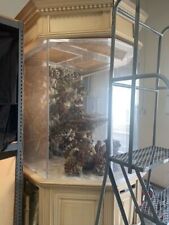Is Cat Coat Color Linked to Temperament?

Common stereotypes are the "archetypal ginger tom" – the flea-bitten, irascible alley cat. Ginger females are "flighty". Confusingly, ginger cats are also quoted as being laid back, but they supposedly have very hot tempers when annoyed – just like human red-heads, especially those of fiery Celtic origin. Oddly enough, ginger coloration in cats is relatively common in Scotland.
A fiery or assertive temperament might be an advantage in some environments – for both cats and humans! Meanwhile, blotched tabbies of either gender are considered "comfortable, home-loving" cats; languid and good pets. Many cards depict tabby cats curled up by a fire as a symbol of domestic warmth and comfort. Black and white cats are said to be wanderers while white cats are shy or nervy. There is a list of characteristics associated with particular colors at the foot of this article.
How much of this is myth and how much is a cat’s color and pattern linked to personality? Both are, after all, inherited and genetically controlled, so it is not impossible for coat color to be linked to temperament. We selectively breed cats for their looks, but seldom for personality. Coat color, fur type and certain personality traits may be linked genetically. In some rodents, the white color is associated with greater docility and increased tolerance of handling which may be why white mice and white rats are common laboratory animals.
Looking for Stereotypes
Part of the problem is that owners expect cats to conform to stereotypes. If you tell people that black cats are sweeter natured and ginger cats a mean tempered, those people are likely to focus on the stereotype behaviors and disregard contradictory behaviors as being "out of character". Human beings dislike chaos and unpredictability and look for order and patterns in everything – that is how we have become the most successful species on the planet – and sometimes we find (or invent) patterns where there are actually no pattern at all.
Having learnt that tortie cats are temperamental or hot-tempered, a shelter helper is likely to approach a tortoiseshell cat much more cautiously. The cat detects this nervousness and is more likely to act up with a nervous helper than with a confident helper. On the other hand, having learnt that blotched tabbies are homebodies and that black cats are mellow, the incautious helper risks nasty injuries when encountering a feral cat which just happens to be a blotched tabby or solid black. There is great danger in looking for stereotypes where none exist.
Black and blotched tabby colors are possibly linked to a less assertive temperament, more placid character and better tolerance of crowding than striped tabby or agouti (ticked). If true, this factor would have contributed to a more sociable cat both with humans and with other cats in a colony situation. The predominance of black/black-and-white in urban environments might therefore be linked to this greater sociability. A stressed cat breeds less successfully and passes its genes on fewer times.
A stressed mother may miscarry or kill her kittens. A cat which is less stressed in a colony situation will pass its genes on more often. Soon, there will be more of the cats showing a coat color linked to sociability and less of the cats showing a coat color linked to unsociability. In the rural environment, a better camouflaged striped cat is likely to be a more successful hunter and will therefore breed more successfully than a less well camouflaged cat.
In a study over a large geographical area in Bavaria, black and black-and-white cats were fund to wander further from home. The study was large enough to suggest that this had a genetic basis and was not purely coincidental. Many professional animal trainers consider black cats to be stubborn and single-minded and more difficult to train to walking on a harness and leash. Some go as far as to consider black cats as hard to work with as uncastrated tomcats, though my own experiences (as a cat owner and cat shelter worker) do not bear this out.
The assertive or reactive temperament is linked to the size of the cat’s adrenal glands. Domestic cats have smaller adrenal glands than the ancestral wildcat, making domestic cats less "flighty". A cat with smaller adrenal glands is less reactive. Alternatively, if cats are in a situation where they do not need to be so reactive, selection (natural or artificial) favors those individuals with smaller adrenal glands as they stick around while the others run away. If the black color really was linked to greater tolerance it would also be linked to the size of the adrenal gland. There is currently no evidence to support this.
Blotched tabby and black are both caused by recessive genes. Two black cats will beget more black cats. Two blotched tabbies will beget blotched tabbies, not striped tabbies. These recessive genes can stay hidden in other-color populations for many generations before resurfacing. If natural or artificial selection favors blotched or black cats, the dominant striped varieties die out because blotched and black breed true. Because recessive genes can be hidden or masked, striped tabbies can produce unexpected blotched tabby kittens so if natural or artificial selection favors striped cats, the blotched or black varieties remain hidden but not lost.
White cats are reputed to be timid or a little dim. Many blue-eyed white cats, and some odd-eyed whites and orange-eyed whites, have hereditary deafness. The white coat color has sometimes been linked to personality traits of slow thinking, dull intellect and (mostly in females) timidity of character – though these traits could equally well be due to deafness.
Where Did Different Colors Arise?
Different colors arose in different parts of the world as spontaneous mutations in local cat populations. Those populations may also have had distinct personalities. The colourpointed pattern arose in Asia and is naturally occurring in Thailand (Siam) and Malaysia. The lilac color may also have appeared in that general area. Blue (gray) possibly arose in Asia where it is now seen in the Korat breed and this color may have spread from there into Russia (Russian Blue).
The ticked and mackerel tabby patterns (and the spotted pattern as this is a form of mackerel tabby) are seen in depictions of ancient cats. Just like the tiger’s stripes, the mackerel tabby pattern provides camouflage in woodland and grasses at dusk and dawn. Other colors would stick out like the proverbial sore thumb and the cat would be a less successful hunter or would be easy prey for something else. The blotched tabby mutation is believed to have occurred in Britain and spread with throughout the former British Empire with human colonists. Blotched tabby is found in the former British colonies, but is less common elsewhere and unknown in some parts.
The natural environment the cat lives in will determine the colors that predominate. Black and white forms predominate in urban ferals, but rural ferals are more likely to be tabby. In a rural environment, striped tabby provides a better camouflage (hence the European Wildcat is striped) and solid color cats would be at a disadvantage.
The tabby pattern breaks up the cat’s outline and blends into the shadows of trees and woodland, when the cat hunts at dusk or dawn. In towns, where cats are frequently scavengers and where they are less likely to be predated upon, black or blotched tabby are not disadvantageous.
Dark-colored cats are believed to be more common where cats live closely with man, therefore, the earlier the urbanization of a place, the greater the proportion of dark forms (at least until the advent of neutering). This theory suggests that where cat arrived in America in the 17th century, the greatest variability in color will be found in the older industrial societies where they have had more time to mutate and where population density has selected for more sociable strains.
Body type and fur length show signs of natural selection (e.g. a stocky rather than lithe body type in American Shorthairs, longer fur in Maine Coons), but the theory regarding color evolution will probably never be proven. The common tabby pattern of the Maine Coon probably reflects that fact that these cats accompanied British colonists all over the world. In Australia, a high proportion of bush cats (rural ferals) have reverted to the brown mackerel pattern (with or without white spotting) which provides the best camouflage when hunting or being hunted.
Which Breed Did That Color Come From?
Black was probably the first color mutation, followed by red and white. Melanistic (black) forms of other cat species occur so it is probably a simple mutation. Different colors arose in different geographical areas. At the same time, different races of cats (what we call breeds) were evolving to suit the local conditions e.g. longhaired cats in colder climates, cobby shorthairs in temperament climates, skinny oriental-type cats in hot climates. Some colors have become associated with particular breeds and with the temperaments of those breeds e.g. Colorpoint (Siamese) in the lithe, extrovert cats of Thailand and Malaysia.
The appearance of the color and the development of the personality trait will have evolved as separate mutations; one is not dependent on the other. When hybridizing cats of different breeds, color and personality may be inherited independently of each other or it is possible that personality traits accompany color traits if the genes for color and the genes for personality sit close together on the cats chromosomes. As the colors spread, any linked personality traits will have spread with them.
The spread of cats and of different color varieties is closely associated with human movement. For example, red (ginger) cats arose in Asia but the main spread of this color is believed to be via northern Europe with the Vikings. Hence ginger is particularly common in Scotland (which had strong links to Viking countries), but is less common in southern parts of Britain where black and blotched tabby are more common. Blue cats spread out of Russia and France and blotched tabbies spread out of Britain.
Part of the influence is through the breeds from which a color was inherited. It is recognized that breeds have very distinct personality types. For example Siamese cats are extroverts and sexually precocious and this trait is passed on to other Orientals which are basically Siamese cats in disguise. The Colorpoint pattern has been introduced into (or suddenly cropped up in) other breeds. It may have been introduced in a roundabout way, but ultimately the pattern traces back to a Siamese-type ancestor even if it was introduced a few generations ago from a Birman or Himalayan.
The extrovert personality may be linked to the Colorpoint pattern, hence Himalayans (Colorpoint Longhairs) are said to be more spirited than self-colored Persians. If the Colorpoint pattern has managed to be passed on through many generations and matings, it is not impossible that some personality traits have been passed on alongside it.
Likewise, the Abyssinians/Somalis are considered to contribute a sweet temperament as well as the agouti pattern when used as an outcross and the "quiet" temperament of the British Blue may be linked to the fact that early breeders did not distinguish between British Blues, Russian Blues and Korats and bred them all together. Russian Blues and Korats are both quiet breeds.
Do People Prefer Some Colors More than Others?
Research suggests that color has a strong influence on what cat people choose. The most popular colors of town cats in the 17th century were black-and-white, gray-and-white or black. Superstition also plays a part with black being considered lucky in some parts of the world. In Japan, mi-ke (tortoiseshell and white) is lucky. In North America, black is unlucky. In various countries different colors are considered lucky or unlucky and this affected the color make up of cat populations as bad luck color kittens were destroyed.
In the 1960s in London, there was a preference for ginger cats or ginger bi-colors. In 1975, a study in Glasgow found that suburban residents in the city preferred cats with ginger or partly white coats. More recently in Southampton, there was a consistent preference for black cats. However cats in more run-down areas of the city were usually black or tabby. In a recent study which rated the attractiveness of 8 cat coat colors, gray was the most preferred color, black was second, with striped and black and white equal third. Ginger was least preferred, with calico as the second least preferred.
Most color/personality "information" is anecdotal, but there have been studies where owners or veterinarians were asked to associate particular colors with particular personality traits. Profiles are only available on two particular breeds and these ignored the breed-specific traits and concentrated on traits "associated" with the color/pattern.
| Color | Persian (Longhair) | British Shorthair | Mixed Breed |
| Black | loyal, suspicious of strangers | good-natured | stubborn, friendly, sociable |
| White | calm, peaceful | streetwise and friendly | timid |
| Red (Ginger) | polite | – | shifty, unpredictable, unfriendly, laid back but with fiery tempers |
| Cream | even-tempered | – | – |
| Blue (Grey) | gentle | quiet, affectionate Possibly inherited from interbreeding with Korats and Russian Blues |
Calm, peaceable |
| Blue-Cream (Dilute Tortie) |
– | lively | – |
| Tortoiseshell | maternal | quick-witted | Naughty, hot-tempered, temperamental |
| Calico (Tortie & White) |
calm, sweet-natured | – | Naughty, lively |
| Black & White Bi-Color |
placid | even-tempered, friendly | wanderers. |
| Tabby | equable | good-natured | Languid, home-loving, good pets. |
| Spotted | – | affable | – |
| Black Smoke | relaxed | good natured (inherited from Persians) | – |
| Pewter/ Shaded Silver |
very affectionate and sweet natured | – | – |
| Cameo | languorous | – | – |
| Colorpoint/ Himalayan |
gentle, spirited but not demonstrative This color originated in Siamese cats. |
– | – |
| Chocolate/Lilac | outgoing, inquisitive These colors were introduced from Himalayans i.e. trace back to Siamese. |
– | – |













